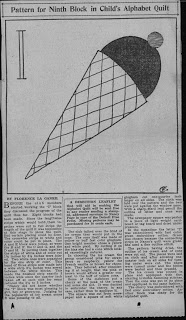In re-reading the column for this block, I was thinking about how Mildred made her templates. She did not make cardboard templates, but used tissue paper patterns, keeping the original newspaper articles intact. I wonder where she got the tissue paper from? It does not have any printing on it, but I wonder if it was left over from a sewing pattern. Maybe you could buy plain tissue for this purpose? It feels a little heavier than sewing pattern tissue.
I told you I had picked out fabric for the borders. Here are my two picks.
 |
| For my quilt |
 |
| For Liz's quilt |
The second one is not a 30's reproduction but the colors are perfect. And it's more gender neutral for a boy or girl that the flowers in the first one.
So here you can see my rabbit blocks too. I forgot to add the stitching for the haunches. I will go back and do that (at the same time I fix my queens eyebrow!)
Here is the column. Enjoy reading it. I get a chuckle of how corny they sound, don't you? I want to go back and do some research on some of her other patterns that she wrote for newspapers after this is done. I'll let you know if I find anything interesting!
Merry Christmas to everyone! I will catch up with you in January.
Block 18-the
Rabbit
To the
children who know a rabbit only as a bunny this block is going to be a puzzle.
Bunny begins with a B and here is a block with the letter R. Nancy was glad that
she had taught her young niece that the right name for this furry, jumping,
hopping creature was rabbit.
Rabbits are
white, white and brown, gray, or black. Nancy chose a white print with soft tan
polka dots for her rabbit. She might have used any of the other colors except
black. This quilt is too soft and quiet in its coloring to include solid black
in its patterns. Of course a white material with black polka dots could well be
used if the dots are not too large and heavy.
For the tail
Nancy used a small piece of Turkish toweling. She might have tufted a tail
right on the white block using candle-wicking in white and bringing the tufts
so close together that a fuzzy tail would have resulted.
Then the
paper pattern was pasted onto a piece of light weight cardboard or tag board
and dried under pressure.
One club
member wanted to know why Nancy always advised pasting this onto a cardboard
backing. “Because newspaper is so flimsy that I am afraid you will lose the
correct outline unless you have strengthened the pattern in some way. Of course
if you are sure you can cut it without tearing and can keep it flat on the
cloth when you cut your pattern you need not bother to paste it to the
cardboard. But I advise it. Then, too, you have the pattern for future use. You
may want to make another quilt. With cheap news paper as a pattern you are
going to find pieces torn off or creased.
After the
paper pattern is dry the rabbit is cut out. A separate piece is cut for the
tail if you are appliquéing that. IF you se the back ground material and
candle-wicking for tufting is not necessary to cut the round pattern.
But all
cloth is cut with a quarter inch allowance on all sides. This is turned under,
basted in place and then the pieces are pressed.
They are
laid over the penciled outline on the white block and pinned in place.
Appliquéing is done with fine, invisible hemming stitches.
The outline
of the rabbits haunch is as shown on the paper pattern is made by using fast
color gray or black in running or outline stitch.
The letter R
is embroidered in the same color fast embroidery cotton as used in the previous
letters. This letter may be done in fine outline or chain stitch.
Nancy was
proud of the “cotton tail” and Joan loved it. She said she just knew that this
was Mr. Peter Rabbit.
Click HERE for the pattern













































